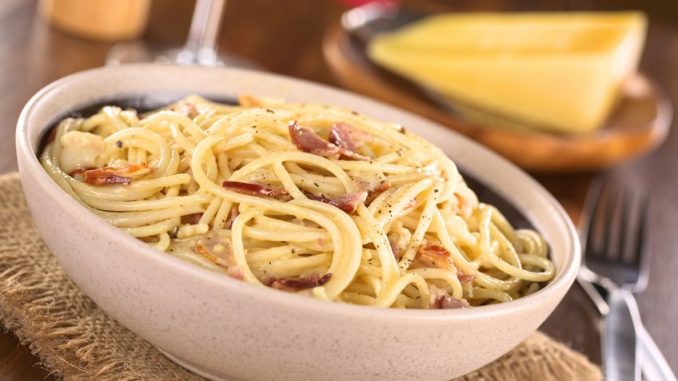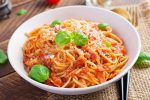
Spaghetti carbonara is a classic of Italian pasta cooking and has one of those iconic sauces that it marks it out as wholly unique. It probably owes as much of its origins to Italian chefs based in New York as it does to the Italian mainland. The dish probably originated in the Lazio region of Italy which makes it almost Roman but not quite. Some chefs also think that GIs going up through the spine of Italy during the 2nd World War were looking for food which appealed to them. There were plenty of eggs and bacon and this dish came out as a result of their endeavours.
There are great Youtube videos by a number of Italian and UK chefs like Antonio Carluccio, Gennaro Contaldo, Jamie Oliver and Gordon Ramsay who offer their insights into how an authentic version is made.
The contentious issue around this dish above all others is the idea of using cream when in fact it is a sauce of just egg yolks with ideally guanciale, pecorino cheese and plenty of black pepper. The fat comes from using guanciale which is the cured cheek of pig and supplies much of the flavour. If you cannot find this particular ‘bacon’ then the next best is pancetta ham and then smoky bacon. No oil should ever need to be used but it helps when it comes to frying very dry bacon! All the fat must be rendered from the guanciale by heat in a pan. This is also used to flavour the whole dish. The other key ingredient which makes it ‘authentic’ is the use of pecorino cheese rather than parmesan although some chefs like Jamie do half and half say. You can use some chopped garlic but it’s not an absolute requirement and is it necessary when all the flavour comes from cured bacon.
Ideally only the egg yolks are used but some chefs allow one of the eggs to include the whites as well. The other key element in preparation is to reserve a cup of pasta cooking water which can be added to help make the sauce smoother.
Here are the steps and directions to prepare this iconic dish easily.
Serves 4: The dish takes about 10 minutes to prepare and 20 minutes of cooking.
Equipment:
[Please note we are an affiliate marketing partner and will make a sales commission if you purchase any items through our affiliate links. Please read our affiliate disclosure]
Ingredients:
- good quality spaghetti 400 g (about 75g per person generally)
- bacon, pork cheeks (guanciale) or lardons 200 g – these need to be roughly chopped into cubes about a cm at most thick. Cut the skin off as this is as tough as old boots.
- 4 egg yolks (the whites are kept for other dishes)
- salt and pepper as needed
- garlic clove – finely sliced and chopped (optional)
- Pecorino 50 g grated (You can use Parmesan of course but pecorino is a better cheese in many people’s eyes for such a dish).
Preparation:
- Cook the spaghetti in a large pan of boiling water and with plenty of salt. The spaghetti must really be al dente. This takes 6 minutes in the water as the rest of the time it will be cooking in the frying pan/skillet.
- Meanwhile, cut the bacon into lardons into cubes. Add to a cool pan to begin with and then heat up. The lardons must fry in a pan as the fat melts to form an oily sauce base.
- With the bacon lardons gently frying, add a little water and cook over a moderate heat for about 10 minutes.
- Beat the four egg yolks in a bowl using a fork, as if to make a typical omelette, add the pecorino cheese, any garlic if desired and a pinch of black pepper.
- Pour the drained pasta into the pan and mix with the bacon and hot oil. Keep some of the water back to add to the pan. A half ladle worth is enough to stop the yolks that will be added to stop clagging and also stop the sauce from scrambling. Allow it to cool for a few seconds and then working quickly add the egg mixture.
- Mix the ingredients gently into the pasta and add the eggs prepared with the cheese, mixing them until they are firm and serve within the hot pasta.
- The residual heat in the spaghetti is meant to heat but not scramble the eggs. For some, there is a food safety issue in relying on residual heat to kill off potential Salmonella but it is feasible to cook this sauce just using the remaining heat in the pan and pasta if the eggs are fresh and responsibly sourced.
- Please add some cooking water if the sauce starts to appear claggy with the pasta.
- Add liberal amounts of freshly ground black pepper and any remaining cheese.
- Serve warm – a plate in the middle of the dining table will say everything about this dish.

Leave a Reply